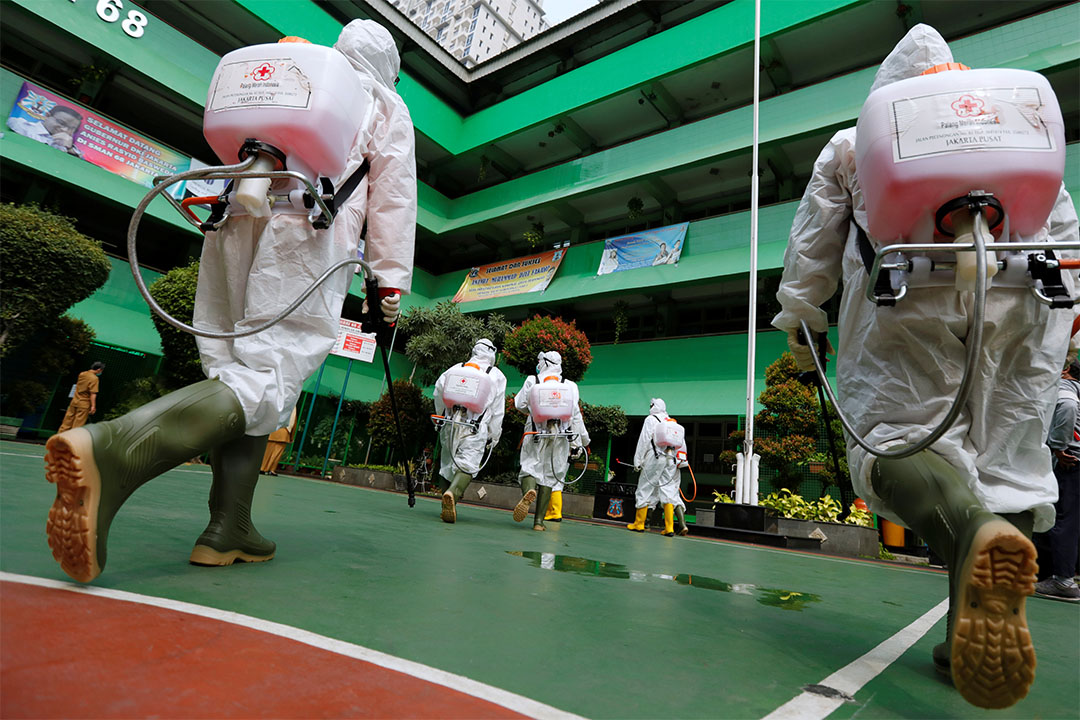
The next few months will be full of grim updates about the spread of the new coronavirus, but they will also be full of homecomings. Patients hospitalized with severe COVID-19, some having spent weeks breathing with the help of a mechanical ventilator, will set about resuming their lives. Many will likely deal with lingering effects of the virus—and of the emergency treatments that allowed them to survive it.
"The issue we're all going to be faced with the most in the coming months is how we're going to help these people recover," says Lauren Ferrante, a pulmonary and critical care physician at the Yale School of Medicine. Hospital practices that keep patients as lucid and mobile as possible, even in the throes of their illness, could improve their long-term odds. But many intensive care unit doctors say the pandemic's strain on hospitals and the infectious nature of the virus are making it hard to stick to some of those practices.
While COVID-19 is sending even young, previously healthy people to the intensive care unit (ICU), older adults are at greatest risk of both severe disease and long-term impairment, says Sharon Inouye, a geriatrician at Harvard Medical School's Hebrew SeniorLife health care system. "It's taken us a long, long time to [develop] some best practices for geriatric care in the hospital and ICU, and I just see all of that being eroded during this crisis."
COVID-19's immediate assault on the body is extensive. It targets the lungs, but a lack of oxygen and widespread inflammation can also damage the kidneys, liver, heart, brain, and other organs. Although it's too early to say what lasting disabilities COVID-19 survivors will face, clues come from studies of severe pneumonia—an infection that inflames the air sacs in the lungs, as COVID-19 does. Some of these infections progress to acute respiratory distress syndrome (ARDS), in which those sacs fill with fluid. That condition sometimes leads to scarring that can cause long-term breathing problems, Ferrante says, but studies show that most ARDS patients eventually recover their lung function.
After any severe case of pneumonia, a combination of underlying chronic diseases and prolonged inflammation seems to increase the risk of future illnesses, including heart attack, stroke, and kidney disease, says Sachin Yende, an epidemiologist and critical care physician at the University of Pittsburgh Medical Center. His team reported in 2015, for example, that people hospitalized for pneumonia have a risk of heart disease about four times as high as that of age-matched controls in the year after their release, and about 1.5 times as high in each of the next 9 years. COVID-19 might prompt "a big increase in these sorts of events," he says.
Patients who spend time in an ICU, regardless of the illness that put them there, are also prone to a set of physical, cognitive, and mental health problems after leaving known as post–intensive care syndrome. The new coronavirus might put ICU survivors at particular risk for some of these problems, says Dale Needham, a critical care physician at Johns Hopkins University's School of Medicine. One reason is the exceptionally severe lung injury it can cause, which leads many patients to spend prolonged periods on a ventilator under deep sedation. A patient with ARDS caused by other illnesses might rely on this life support for 7 to 10 days, Needham estimates, but some coronavirus patients require more than 2 weeks.
Many COVID-19 patients who need a ventilator never recover. Although survival rates vary across studies and countries, a report from London's Intensive Care National Audit & Research Centre found that 67% of reported COVID-19 patients from England, Wales, and Northern Ireland receiving "advanced respiratory support" died. A study in a smaller patient group in China found that only 14% survived after going on a ventilator.
Those who survive a long period on a ventilator are prone to muscle atrophy and weakness. Keeping a critically ill patient moving—raising their arms and legs, and eventually helping them sit up, stand, and walk—can reduce that weakness and get them off the ventilator faster. But because SARS-CoV-2 is so infectious, bringing rehab specialists into patients' rooms can be a challenge, Needham says.
In Needham's ICU at Johns Hopkins, these specialists are donning protective gear to help people on ventilators stay moving. But Ferrante says that at many major hospitals, including hers, a shortage of such equipment has kept physical therapists away from COVID-19 patients. And even when people are well enough to leave the ICU or the hospital, many still have the virus, she says, and may have to wait until they're not contagious to get inhome care or visit a rehab facility.
Another risk for hospitalized patients is delirium—a state of confused thinking that can lead to long-term cognitive impairments such as memory deficits. "What we're finding in COVID is that there's a ton of delirium," says E. Wesley Ely, a pulmonologist and critical care physician at Vanderbilt University whose team is preparing to publish those findings. The virus itself is partly to blame, Ely says. He suspects this coronavirus, like the ones that cause severe acute respiratory syndrome (SARS) and Middle East respiratory syndrome, can directly infiltrate and damage the brain. And bodywide inflammation caused by the virus can also limit blood flow to the brain and kill brain cells.
Making matters worse, doctors commonly prescribe sedative drugs to suppress violent coughing and help patients tolerate the distress and discomfort of a breathing tube. But these drugs can increase the risk of delirium, Ely says. And as hospitals run short of the most commonly used sedatives, they're turning to benzodiazepines, a class of drugs that can cause "intense and prolonged delirium," he says.
Over the past 20 years, Ely and colleagues have developed a checklist, now adopted by many ICUs, to improve patient care and outcomes. Among its priorities: a daily interruption of narcotics and sedatives plus a decrease of ventilator pressure to test whether patients can wake up, breathe, and tolerate the ventilator without drugs. (If they can't, doctors are urged to restart these drugs at a lower dose.) But the practice requires close monitoring, and in ICUs overstretched by COVID-19, "I think that's getting skipped," Ely says. "Everybody out there is trying to do their best," he notes. "But let's not throw out all the things we've learned in the last 20 years."
The threat of infection has limited the bedside interactions that can help patients stay calm and reduce the need for delirium-inducing drugs. "If you could design a system to be bad for how you care for older adults, you would make it such that no one could go in the room, and the family would not be allowed to visit, and … everyone has to go in with face masks and all gowned up, so they're completely frightening," Inouye says. Doctors do need to sedate and restrain agitated patients to keep them from pulling out their IV or breathing tubes, she says. "And yet I'm wondering, could we possibly take 2 minutes to try to calm them, to have someone there who's gloved and masked, to hold their hand and stroke their arm?"
Early reports from ICUs battling COVID-19 suggested patients should be put on ventilators early in the course of the disease, says C. Terri Hough, a pulmonary critical care physician at the University of Washington, Seattle. "That was our approach here for our first handful of patients." Part of the logic was that a less invasive alternative—delivering a high flow of oxygen into the nose—might send the patient's viral particles into the surrounding air, increasing the risk of infecting others. And if a patient declined quickly, doctors would be forced to do a riskier emergency intubation. But Hough's team "quickly got worried about all the downsides of early ventilation," she says. She and her colleagues are now trying to tease apart subtypes of respiratory failure in coronavirus patients to help them decide which patients need ventilators and when. "As we learn the faces of the disease, we're seeing our practices shift," she says. "If we're putting more people on ventilators than maybe we need to, that certainly is going to affect the population health after recovery."
Poor survival odds and the potential for long-term complications force difficult conversations for older patients, families, and clinicians. "I was initially really upset when I was hearing about the rationing of ventilators from older adults," Inouye says. But when COVID-19 broke out at her 91-year-old mother's assisted living facility, she and her sister made plans to tell hospital staff that if their mother got sick, she did not want to be kept on a ventilator when the hope of recovery was slight. (The facility has now passed 14 days without a new coronavirus case.)
"Because of the decision-making about my mom's case, and because of realizing how scarce the ventilators are, I do think we have to take it one-on-one—we have to go by what that person's wishes are and what their family's wishes are," she says.
As hospitals struggle through the current surge of cases, researchers are also trying to look ahead. Ely's team is testing a tablet-based rehabilitation program for people who have cognitive impairment after being hospitalized for a critical illness, which he describes as "Sudoku and Scrabble on steroids." Yende's team is piloting a care approach for discharged pneumonia and sepsis patients that includes monitoring them using computers and smartphones and visiting them at home or treating them remotely in hopes of preventing readmission to the hospital.
Others are preparing for a surge in mental health problems, among them anxiety, depression, and post-traumatic stress disorder following the psychological stress of severe disease. A study of people hospitalized for SARS found that more than one-third had moderate to severe symptoms of depression and anxiety 1 year later. Hough and her collaborators are testing a mobile app that promotes mindfulness and coping skills in people leaving the hospital.
The global emergency could lead to a stronger support system for survivors of any critical illness, Hough says. "This we're-all-in-this-together attitude around coronavirus may actually provide hope that wasn't there before."








